Reclaiming Spiritual Wholeness
In Isaiah 11:6-9 and Hosea 2:18, we read of a world with no more war or killing. But in Numbers 31 and Deuteronomy 20, we find divine commands to raze cities and kill every living being in them.
Jesus preached love and peace. But Revelations 12-19 tells of “the wrath of God upon the earth” and how mass killings are unleashed by divine violence.
How did we get these conflicting messages? How can we sort them out so our scriptures can no longer be used to incite hate and violence?
My Spiritual Journey
As a child refugee from Nazi Europe to Cuba, I took religion for granted. Every night at bedtime, I repeated after my father the Jewish evening prayer, the Shema. I didn’t understand the Hebrew words, but I understood that we were appealing to a spiritual power in which we placed our trust. After the Shema, I said my own prayer and, as children will, I always made sure I didn’t forget a single name of those in our family who had not escaped the Nazis: my grandparents, aunts, uncles, cousins. Then World War II ended and I found out about the Holocaust. There are no words to describe what I felt as I grieved not only for the dead of my family and my people, but for the faith I lost. How could God let this happen?
I still found comfort in biblical passages such as the poetry of some Psalms and the Jewish tradition of helping others. But I also began to open my eyes to passages teachings violence, cruelty, and inhumanity – and was appalled that I had never reflected on them.
It wasn’t until years later that I began to research the history of religion. This research was part of a multidisciplinary, historical, cross-cultural study to identify what kinds of societies support our human capacities for consciousness, caring, and creativity, or, alternately, our capacities for insensitivity, cruelty, and destructiveness.
This study went beyond conventional social categories such as right/left, religious/secular, capitalist/socialist, Eastern/Western, since there have been violent and oppressive regimes in all these categories, and on top of that, as I began to realize, they all marginalize or ignore the majority of humanity: women and children. Drawing from a more complete database that includes the whole of humanity and the whole of our history made it possible to see patterns or configurations that are otherwise not visible: the authoritarian, male-dominated, violent domination system and the more democratic, gender-balanced, caring partnership system.
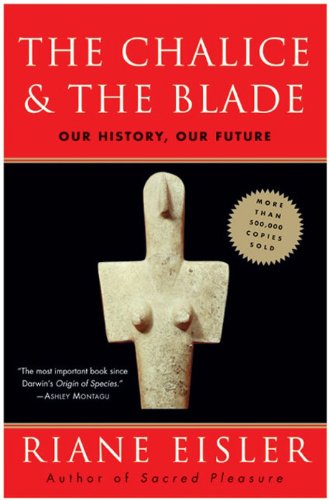 The first book detailing these findings was The Chalice and the Blade: Our History, Our Future (now in its 57th US printing and 27 foreign editions). It demonstrated that our early cultural direction, for millions of years, was in a partnership direction, until there was a shift toward domination just a few thousand years ago.
The first book detailing these findings was The Chalice and the Blade: Our History, Our Future (now in its 57th US printing and 27 foreign editions). It demonstrated that our early cultural direction, for millions of years, was in a partnership direction, until there was a shift toward domination just a few thousand years ago.
This shift from a partnership to a domination direction in most world regions explains why at the core of our major faiths — Hindu, Buddhist, Muslim, Hebrew, Christian — are values of sensitivity, empathy, and nonviolence that are more congruent with our human need for caring connections. However, like a beautiful old picture painted over, around these partnership teachings are passages that justify in-group versus out-group domination, top-down control, and violence.
Our Spiritual History and Prehistory
Many prehistoric images of deity emphasize life giving and nurturing. This is the aspect of the divine some theologians call God as Mother today.
Marija Gimbuts, Alexander Marshack, James Mellaart, and other scholars note that the 30,000 year-old Stone Age nude figures that nineteenth century archeologists mislabeled “Venuses” are the first Western Goddess representations. Twenty thousand years later, in farming societies of the Neolithic like Catal Huyuk (circa 7000 to 3500 B.C.E.), female images still predominate, indicating a millennia-long cultural continuity. There were also male deities in these societies, but they were not associated with thunderbolts (like Jehovah or Wotan) or weapons (like Zeus or Thor), suggesting that masculinity was not yet equated with violent domination and conquest.
Then came a massive cultural shift, shown by both archeology and legend. For instance, in the Enuma Elish, a four thousand year-old Babylonian epic, the war god Marduk dismembers the body of the Mother Goddess Tiamat to create land and sea. Earlier myths from that region credit a Mother Goddess not only with creating the world, but as the source of life, love, wisdom, and prosperity.
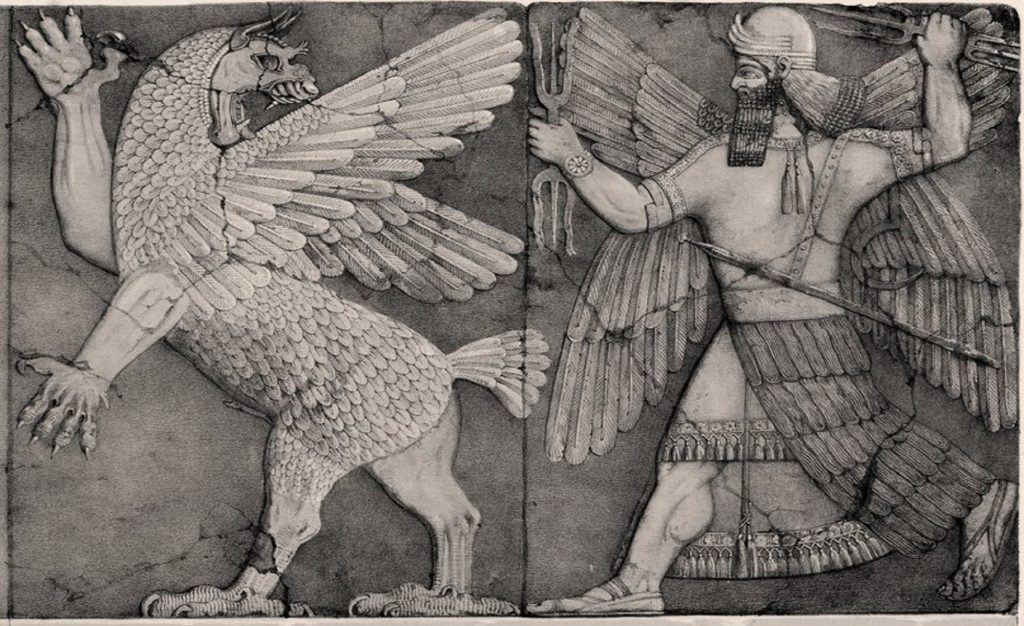
Archeological excavations show that the first art idealizing armed male force came late in Western cultural evolution. In Europe, this art dates from the Indo-European invasions (circa 4000-3000 B.C.E.), which brought an ethos of conquest and domination. In The Chalice and the Blade in Chinese Culture, examining cultural transformation in Asia, scholars at the Chinese Academy of Social Sciences in Beijing show that this shift also took place in China. Anthropologist June Nash’s study of the Aztecs shows a similar shift in the Americas.
This information is still not widely disseminated. However, if we know what to look for, we find traces of more partnership-oriented cultures in all world traditions – often in plain sight.

In the Bible, when the prophet Jeremiah rails against the Hebrew people for backsliding from the worship of Jehovah, they respond that there was peace and prosperity when women baked cakes for the Queen of Heaven (Jeremiah 44:15-17). Ancient Greek, Indian, and other traditions are full of female deities, even though most are already subservient to male ones. The Christian Mary is the Mother of God, and while she is now the only mortal figure in a pantheon in which only the father and son are divine, like the Goddess of old, she is associated with love and compassion.
Since the veneration of female deities originated in more partnership-oriented times, it is no coincidence that female images of the divine are reemerging in our time of partnership resurgence. For example, theologian Sallie McFague notes that seeing God as the parent who feeds the young and, by extension, the weak and vulnerable, understands God as caring rather than as punitive.
This is an important trend toward partnership, and of course, gender equity. How we see God has huge consequences for what we think is normal and moral. However, I want to emphasize, as I do in all my work, that this matter of guiding values is not a matter of women against men. It is a matter of recognizing something that has directly impacted us all.
This domination model of our species in which the male form is considered superior and dominant to the female form impacts whether we really value democracy and caring or value violence and authoritarian control. With the shift to the authoritarian, violent, top down domination system – be they brutal tribal chieftains, Roman or Christian emperors, Muslim sheiks, Indian pashas, or the regressions to domination we see today — came a gendered system of values in which anything stereotypically associated with women or the “feminine” like caring, caregiving, and nonviolence is devalued. This devaluation, and these gender stereotypes, is what children are taught through their socialization in domination-oriented cultures and subcultures,
Beginning in the authoritarian, male-dominated, highly punitive families that are the norm in domination cultures, boys are taught they must never be like a woman, and men who are caring and sensitive are labeled wimps, sissies, and girlie men. So both women and men from these backgrounds tend to support punitive policies such as funding for prisons (the familiar punitive male head of household). But somehow they can’t find money for caring for people, for child nutrition, childcare, healthcare, or keeping a clean and healthy environment (in domination systems associated with women and the “inferior feminine”).
Pain and Pleasure
This distorted system of values is reflected in our spiritual heritage. Despite core teachings of love and nonviolence, in both Eastern and Western scriptures, story after story and commandment after commandment idealize the infliction or suffering of pain. Many sacred stories and images portray acts of killing and dying. But images of giving birth are totally absent.
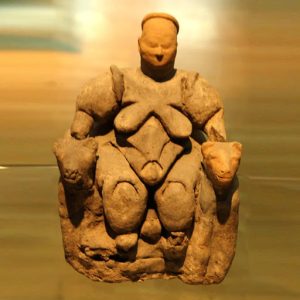
By contrast, as detailed in Sacred Pleasure: Sex, Myth, and the Politics of the Body, in earlier, more partnership-oriented societies, birth-giving images are prominent. For example, in the Neolithic site of Catal Huyuk in Turkey, we find an 8000 year-old figure of a seated Goddess giving birth.
When I first looked at these images, it seemed natural to make giving life rather than ending life sacred. But I was still taken aback by Neolithic and Bronze Age art in which sexuality was a sacred part of life and nature – even though this makes sense in a spirituality, and society, where pleasure rather than pain holds relations together.
This is not to say that in these more partnership-oriented societies pain was absent. There are illnesses, natural disasters, death, and other causes of pain in every society. But the emphasis seems to have been not on pain and death but on pleasure and life.
So in the biblical Song of Songs, we still find traces of this earlier pleasure-oriented spiritual tradition. The beautiful Shulamite, the Rose of Sharon, sings to her lover, “I am my beloved’s and my beloved is mine . . . a bundle of myrrh is my well-beloved unto me; he shall lie all night betwixt my breasts.”
Mystical writings also contain clues to a time when woman’s body, man’s body, and sexuality were part of the sacred. In our mystical spiritual literature, as in our romantic literature, we find repeated references to passion and joy, often in erotic language.
But this joy and pleasure are not self-centered, frantic “fun” – all too often at someone else’s expense. It is not the escape from pain mistaken for pleasure in domination-oriented societies. It is the joy of love, the fulfillment of sharing, the awe at the miracle of life and nature, and the ecstasy of heightened states of consciousness.
By contrast, consider the message of the Christian doctrine that pain is our lot in this “vale of tears,” and all that matters is a better life after death. Or of the Hindu dogma that the caste system is divinely ordained. Or of the Buddhist teaching that our only hope is disengaging ourselves from what is happening around us while trying to do no harm.
These teachings have helped some people cope with the suffering and injustice inherent in domination systems. But they have served to maintain domination systems, teaching that pain and suffering are our inevitable lot.
When I started to question these teachings, I felt uncomfortable. But I had the analytical lens of the partnership-domination continuum. So I could see that the reason for teachings that we should just accept pain wasn’t religious. It was a political message designed to maintain the suffering caused by domination systems, be it in families or in the world at large.
Sex, Violence, and the Sacred
By the Christian Middle Ages, over and over, the emphasis is no longer on pleasure, but on pain.
Mystics flagellate themselves. They lie on beds of nails. They tattoo their bodies with hot irons. They write about this cruelty to their own bodies as an ecstatic road to oneness with God.
A transformation of both myth and reality has taken place. Ancient myths and symbols have been radically changed to meet the requirements of a system that elevates male over female and is primarily held together by pain and fear rather than pleasure and caring connection.
Men are taught to think of sex in terms of control over women, of entitlement to women’s bodies. The Bible has rules that require men to stone to death women suspected of sexual independence. For hundreds of years, the Church condemned every sexual position except man on top and woman on bottom – what came to be known as the “missionary position,” subconsciously programming women to accept subordination and men to think of domination as normal, sexually exciting, even moral.
For century after century, the pleasures of the body were linked with sin and punishment. While the medieval Church condemned sex for pleasure as a sin, it never called sexual violence against women a sin. Instead, in the Malleus Maleficarum, the medieval handbook for persecuting and burning “witches” blessed by Pope Innocent VIII, the Church labeled woman as more carnal, and hence more sinful, than man.
Nor did the Church condemn the constant warfare of medieval kings and nobles. The Church itself instigated hate and violence like the Crusades and Inquisition. It blessed the witch-hunts, during which, by the most conservative estimates, 100,000 European women were tortured to death (given the small population of Europe in those times, this slaughter of women was a holocaust).
This domination “spirituality” is not the spirituality of the great religious visionaries of history. Isaiah, Jesus, and Hildegard of Bingen did not ask us to tolerate injustice and cruelty. They tried to change things: Isaiah preached we should do unto others as we would want them to do unto us; Jesus also preached this and acted on it by stopping the stoning to death of a woman; Hildegard stood up to a pope.
All this takes us back to the fact that at the core of the major faiths — Hindu, Buddhist, Muslim, Hebrew, Christian — are partnership values of sensitivity, empathy, caring, and nonviolence. These are the spiritual values that support the relationships we yearn for.
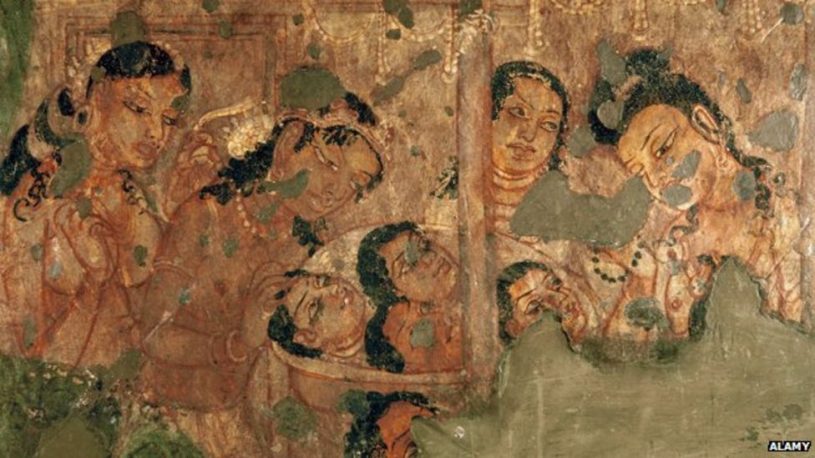
Unraveling and Reweaving
All around us, we see moral and spiritual confusion. On one side are those who incite scapegoating and violence under the guise of religion, spirituality, and morality. On the other side are those who consider ethical and moral standards nothing more than cultural constructs that vary from time to time and place to place. And, as we saw, if we look at our traditional religious scriptures, we are confronted by massive contradictions.
If these contradictions distress us and we flee east, like some in New Age circles, we face the same problems. A well-known Hindu story celebrates how when the god Vishnu was a baby and his father decided to kill him, a girl baby was put in his place. The Muslim Koran says that a husband should beat a disobedient wife. In the Hindu epic Mahabharata, “superior” violence is a divine attribute as deities engage in bloody battles.
What do these teachings tell us about the value of a girl’s life compared to a boy’s? What do they teach about human relations in general – about the “morality” of using force to impose one’s will on others? Or about the “morality” of killing human beings considered less valuable than others?
How can we make sense of the biblical commandment “Thou shalt not kill” when passage after passage contradicts this commandment? What do we do with biblical passages approving of slavery (Leviticus 25: 44-46) and of a man selling his daughter into slavery (Exodus 21:7)?
We each must sort out this dark side of our religious heritage, and bring together religious leaders of all faiths to do this. If we don’t, we perpetuate a system that continues to cause enormous suffering.
We must leave behind the domination part of our religious heritage and strengthen the partnership spirituality and morality we so urgently need.
The first step is to start sorting out the partnership from the domination teachings in our scriptures, and share this with others in our sphere of influence.
If we don’t, we can’t successfully counter the religious hate-mongering regaining strength today. Nor can we counter the rudderless view that there are no moral or ethical human rights standards or that to insist on standards is being “too judgmental.”
The second step is re-examining the norms and structures around us to see if they support a spirituality, morality, and consciousness appropriate for partnership or domination relations.
If we are sensitive to others, we cannot enforce rigid rankings backed up by fear and force. As documented by the neuroscience described in Nurturing Our Humanity: How Domination and Partnership Shape Our Brains, Lives, and Future (Riane Eisler and Douglas Fry, Oxford University Press, 2019), moral sensitivity has to be suppressed in relations between “superiors” and “inferiors”– be it in families and workplaces or politics and economics. Even our language reinforces the notion that our only alternatives are dominating or being dominated; for example, terms like matriarchy and patriarchy for gender relations. In the language we inherited, there is no partnership alternative. This is why the new language of partnership systems and domination systems, along with terms like empowering hierarchies of actualization, rather than disempowering hierarchies of domination, is so vital
The third step is bringing religious and spiritual leaders from all faiths together to use the tool of the partnership-domination social lens to sort our religious teachings.
This is essential, and every one of us can do something to make it happen. We can all communicate with religious leaders and organizations, starting with those in our own sphere. My book The Power of Partnership (from which parts of this article are adapted) is an excellent tool, showing how partnership and domination system lead to very different relations across the board — from how we relate to ourselves and in our intimate relations to our relations with our Mother Earth and our spiritual relations. And Nurturing Our Humanity provides the latest evidence, including findings from neuroscience, on how these two systems affect people’s brains – and hence how we think, feel, and act, including how we vote.
We can change our spiritual teachings: they were changed before. To build a world where our human need for caring connection is honored and supported, we must separate the grain from the chaff in our scriptures. We can each play a part in leaving behind teachings idealizing pain, death, and hate and re-creating a partnership spirituality focused on joy, life, and love.




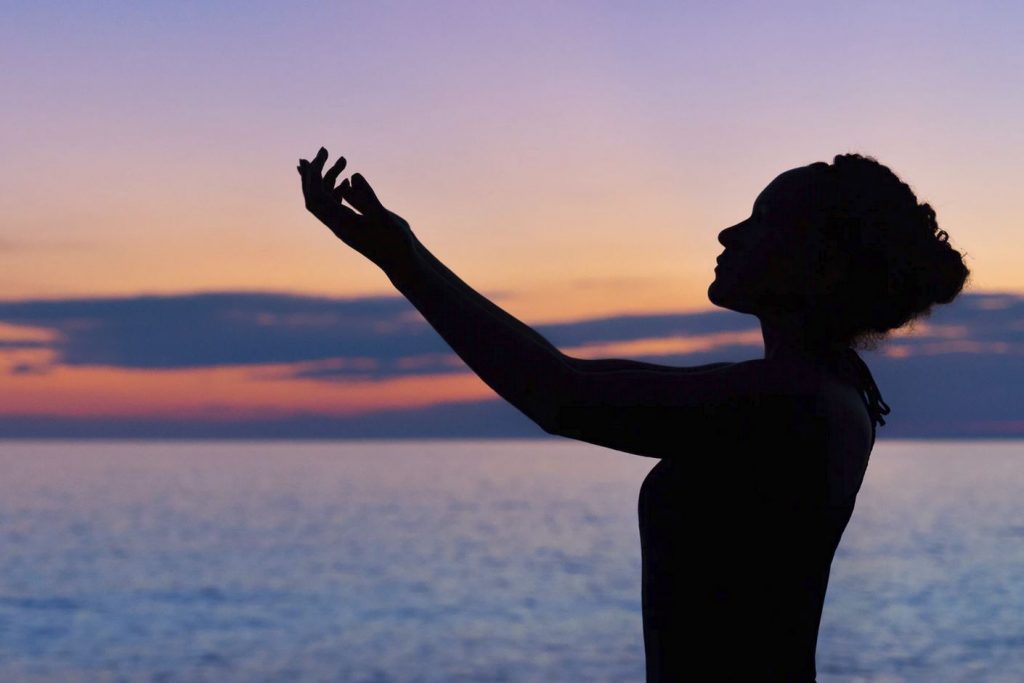
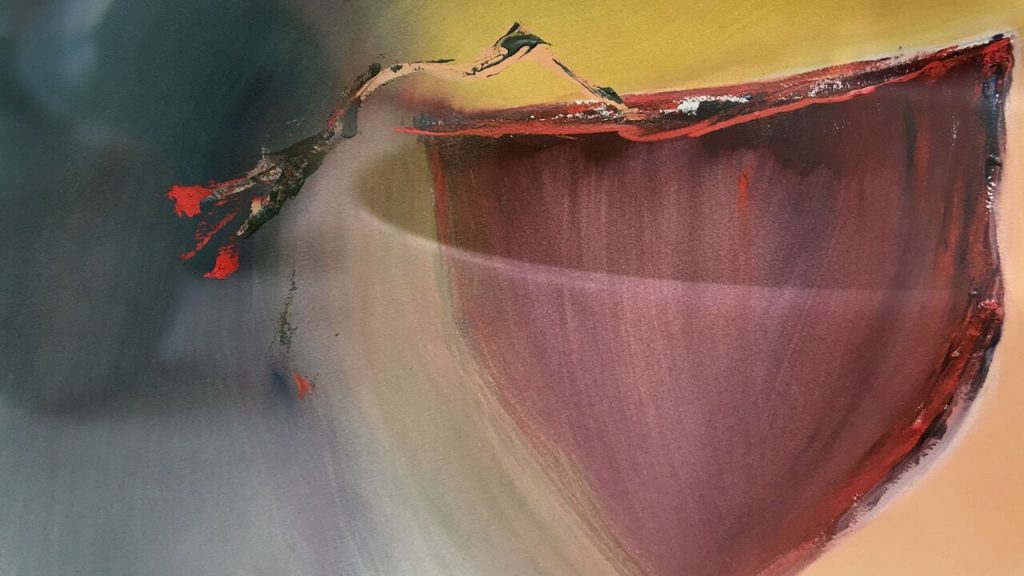

This article by Riane Eisler offers insightful analysis, not only of the world’s religious history but also genuine steps toward shifting from domination in many forms to several practical strategies for building a new world of social partnership. Caring and communication are so much more effective in efforts to build a better world than hierarchies and power grabs. I look forward to reading more of her work, as well as further articles by other authors in the Kosmos Journal.